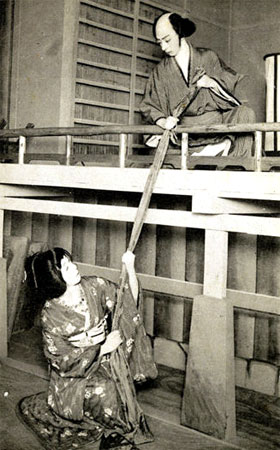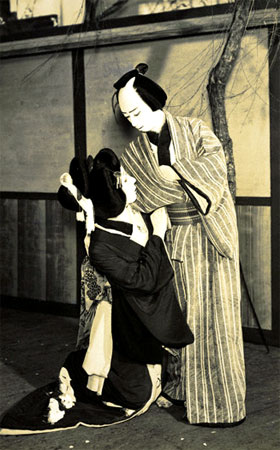| IKUTAMA SHINJ█ |
| Play title | Ikutama Shinjű Ume no Naniwa Ikutama Shinjű |
| Author | Chikamatsu Monzaemon (1715) Uno Nobuo (1949 revision) |
| History |
The play "Ikutama Shinjű" was originally written for the puppet theater (Bunraku) and staged for the first time in ďsaka at the Takemotoza in the 8th lunar month of 1715. It was based on a real event that happened in ďsaka in the 5th day of the 5th lunar month of 1715. A man named Kaheiji, the son of the chawan'ya Hitotsuya Gohŕ, and the courtesan Kashiwaya Osaga, committed suicide together in the woods near the Ikutama Shrine. "Ikutama Shinjű" went quickly into oblivion and was eclipsed by the success of Chikamatsu Monzaemon's 1703 masterpiece "Sonezaki Shinjű". Therefore, it was not adapted for Kabuki during the 18th or 19th centuries. It was revived by a Shinpa troupe in 1903 in ďsaka. The first Kabuki revival happened in January 1913 and it was staged at the Kabukiza. This revival was entitled "Ume no Naniwa Ikutama Shinjű". After WWII, Kema Nanboku wrote a new script, which was entitled "Osaga Kaheiji" and staged in September 1946 at the Bunrakuza (unknown casting) and in January 1947 at the ďsaka Kabukiza [more details]. Uno Nobuo wrote a new script for "Ikutama Shinjű", which was staged in December 1949 at the Mitsukoshi Gekij˘ [more details]. Uno Nobuo's version of "Ikutama Shinjű" became the Kabuki standard. |
| Structure |
The original puppet drama was in 3 acts. The current Kabuki version is made up of two acts, "The Shimizuya Tea House at Tenma" and "The Branch Store at Yamatobashi". |
| Key words |
Chawan'ya Gidayű Ky˘gen Giri/Ninj˘ Ikutama Ikutama Jinja Inden'ya Michiyuki Sewamono Shinjű Shinjűmono Tenma |
| Summary |
Tenma Shimizuya The courtesan Kashiwaya Osaga arrives by a palanquin at the Shimizuya tea house in Tenma (ďsaka), where a customer is waiting for her. Instead of going to see him straight away, she makes the two palanquin bearers go to his room to drink with him, asking them to tell him that she has to take a rest because she has a headache. Actually she has made an arrangement to meet her lover, Hitotsuya Kaheiji, who is the heir to the chawanya Hitotsuya Gohŕ. Soon Kaheiji arrives and, seated on a bench with her, tells her that he has been expelled from his father's house and is now living in his father's branch store at Yamatobashi. According to Kaheiji, Gohŕ wants to marry him to his niece Okiwa, whom he adopted when she was a baby, and is therefore strongly opposed to Kaheiji's intimacy with Osaga. Moreover, Kaheiji has neglected his business and spent all his money in the pleasaures quarter. He has also borrowed 300 ry˘ from friend, the inden'ya Ch˘saku, who is supposed to come to the Shimizuya today. Kaheiji suddenly notices the approach of Oriku, his elder sister, accompanied by his younger brother Ikumatsu, who is suffering from an eye disease, and a maid. Kaheiji and Osaga hide themselves in the palanquin but Osaga is soon compelled to come out as her customer and the palanquin bearers come to look for her and invite her inside the tea house. Oriku, who has apparently noticed the presence of Kaheiji in the palanquin, tells Ikumatsu about his elder brother's misconduct. Ch˘saku arrives and Osaga comes out to greet him. With Kaheiji still hiding in the palanquin, Ch˘saku calls Kaheiji a swindler and urges Osaga to switch her love to him. Furious but unable to go out because of the presence of his Oriku, Kaheiji suffers silently and powerlessly in the palanquin. Fortunately a messenger comes to tell Kaheiji's sister that her husband is calling her, so Oriku hurriedly goes away with Ikumatsu and the maid. Kaheiji immediately runs out of the palanquin and begs Ch˘saku to be patient regarding the payment of the 300 ry˘. Ch˘saku mocks Kaheiji and they soon begin to fight. It develops into a bigger fight as they are joined by Osaga's customer and the palanquin bearers. Kaheiji is heavily beaten up and Ch˘saku leaves the tea house, fully satisfied. Yamatobashi Demise Two servants from the Kashiwaya, Osaga's master tea house, arrive at Gohŕ's branch store at Yamatobashi. They are looking for Osaga, who has not come back to his tea house for several days. Kaheiji has been absent for several days and the shop is empty. The messengers discuss with S˘bŕ, a dyer who lives next door, but they have to leave without getting any clue for Osaga's whereabouts. An old man comes as Ch˘saku's messenger to collect money but he too goes away empty-handed. Kaheiji and Osaga then come down the hanamichi. Seeing them enter the store, the landlord sends a messenger to Gohŕ's house to report their return. Presently Gohŕ arrives with his adopted daughter, Okiwa, and knocks on the door. Kaheiji helps Osaga hiding herself, climbing out from the window, hanging by a sash and being on a little wooden platform outside the store so that she cannot be seen by Gohŕ and Okiwa and then opens the door. Gohŕ demands that Kaheiji marry Okiwa by all means. Showing a dagger to him, Gohŕ says he will kill himself if Kaheiji says no. So strong is his demand that Kaheiji cannot but obey him though he has no intention of marrying Okiwa. Glad of his consent, Gohŕ gives Kaheiji enough money to repay all his debts. After Gohŕ and Okiwa have gone home, Ch˘saku personally visits the store together with a few followers to demand that Kaheiji pay the money he says Kaheiji owes him. Kaheiji refuses and they start fighting again. Hit on the head by Kaheiji, Ch˘saku runs away into the darkness. Kaheiji finds to his dismay, however, that Ch˘saku's followers have taken away the money given to him by his father. Gohŕ's dagger in hand, Kaheiji is about to run out of the store when the landlord's employees block him. Kaheiji jumps out of the window to join Osaga on the platform, which is connected to the other side of the river. The plays ends here. The final scene, the michiyuki, is no more in the repertoire. Arriving at the pine grove at the Ikutama Shrine, Kaheiji and Osaga sit on a haori spread on the ground. Kaheiji tells Osaga that in his last moments his mind is occupied with the thought about his father and dead mother. Osaga says she too fondly remembers her dead mother. They then kill themselves with a dagger. |
 |
 |
|
|
The actors Nakamura Utaemon V (bottom/left) and Ichimura Uzaemon XV (top/right) playing the roles of Kashiwaya Osaga and Hitotsuya Kaheiji in the drama "Ume no Naniwa Ikutama Shinjű", which was staged in January 1913 at the Kabukiza |
The actors Nakamura Fukusuke VI (left) and Morita Kan'ya XIV (right) playing the roles of Kashiwaya Osaga and Hitotsuya Kaheiji in the drama "Ikutama Shinjű", which was staged in October 1936 at the Shinjuku Daiichi Gekij˘ |
|
|
|
| Contact | Main | Top | Updates | Actors | Plays | Playwrights | Programs | Links | FAQ | Glossary | Chronology | Illustrations | Prints | Characters | Derivatives | Theaters | Coming soon | News |